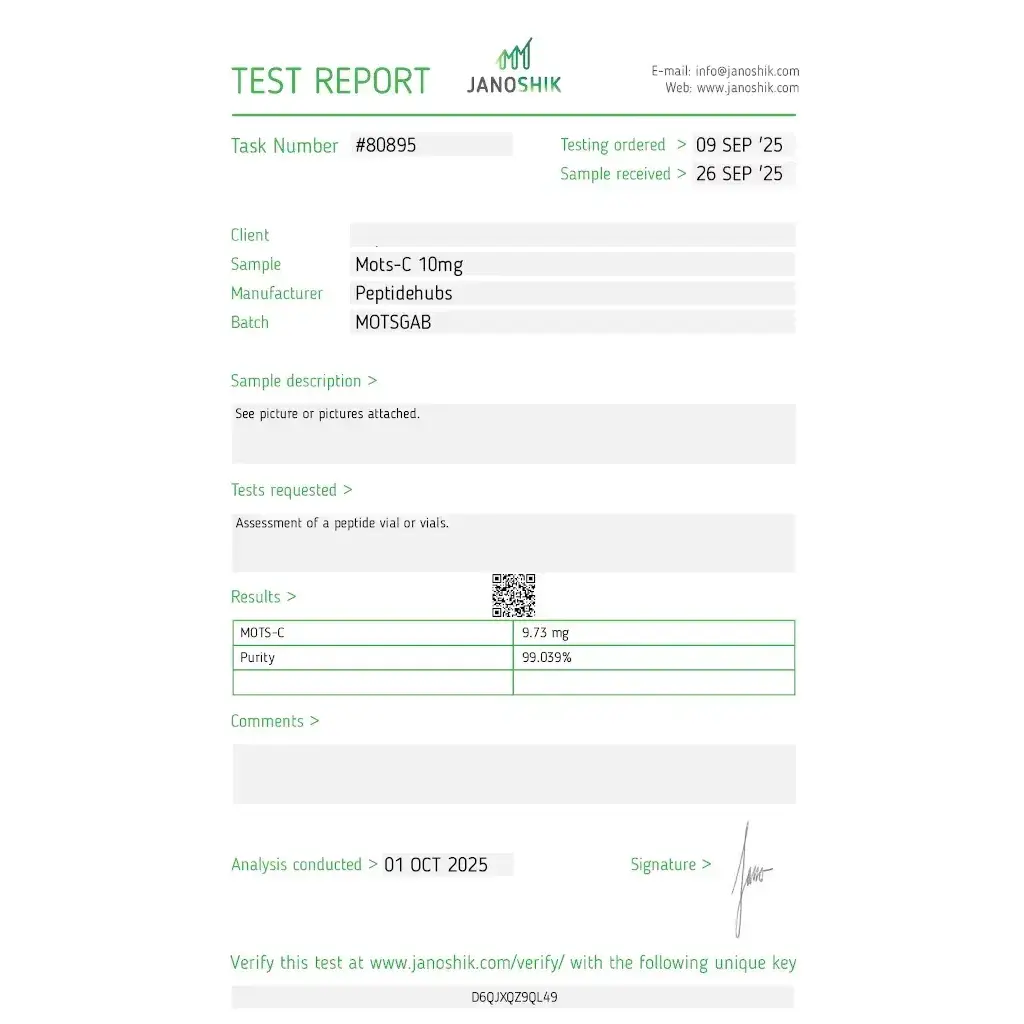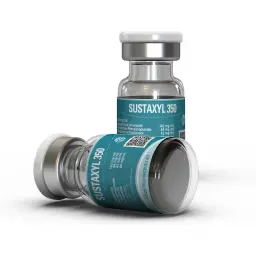



Drug Class: Mitochondrial-Derived Peptide
Composition: MOTS-c (Mitochondrial Open Reading Frame of the 12S rRNA-c)
Dosage: 10 mg/vial
Form: Lyophilized (Freeze-Dried) Powder
Unit: 2 mL Vial
Brand: Peptide Hubs
Laboratory Test: View Lab Report
For Research and Laboratory Use Only
MOTS-c stands at the forefront of a new era in peptide science, representing a paradigm shift in our understanding of cellular energy and metabolism. Unlike traditional peptides encoded by nuclear DNA, MOTS-c is encoded within the mitochondrial genome itself, acting as a powerful signaling molecule that coordinates metabolic homeostasis. Peptide Hubs offers a premium 10 mg vial of this groundbreaking peptide, verified by third-party lab testing, providing researchers with a pure and potent tool to explore the intricate links between mitochondrial function, exercise performance, and age-related metabolic decline.
MOTS-c (Mitochondrial Open Reading Frame of the 12S rRNA-c) is a recently discovered, 16-amino acid peptide that is encoded in the mitochondrial DNA and expressed in various tissues. Its discovery challenged the long-held belief that the mitochondrial genome only encoded proteins for the electron transport chain. MOTS-c functions as a mitochondrial signal to the nucleus, influencing gene expression to optimize metabolic function under stress conditions. Its primary mechanism involves activating the AMPK pathway, a central regulator of cellular energy often called the "metabolic master switch." This pathway is famously activated by exercise and metformin. By mimicking this state, MOTS-c promotes glucose uptake and fatty acid oxidation while inhibiting the folate cycle and de novo purine synthesis, which shifts the body's metabolism. For foundational scientific research, you can explore the seminal 2015 study on MOTS-c published in Cell Metabolism.
The effects of MOTS-c are profound and systemic, targeting the very core of cellular energy production and utilization. This makes it a subject of intense interest for researchers in sports performance, obesity, and aging.
MOTS-c is typically reconstituted with Bac Water and administered via subcutaneous (SubQ) injection. As a relatively new peptide, research protocols are still being refined, but established dosing ranges have shown efficacy and safety in preclinical models.
MOTS-c's unique mechanism makes it an excellent base for stacks aimed at comprehensive body recomposition, performance enhancement, and longevity.
MOTS-c is renowned for its exceptional safety profile. As an endogenous peptide (naturally produced in the body), it is generally very well-tolerated in research settings with a low incidence of side effects.
Your Peptide Hubs MOTS-c 10 mg vial arrives as a lyophilized powder. To reconstitute, gently inject 1-2 mL of Bacteriostatic Water into the vial, directing the stream against the glass wall to avoid damaging the fragile peptide structure. Roll the vial gently between your hands until the solution is clear and all powder is dissolved. Do not shake. Once reconstituted, store the vial in a refrigerator and use it within a few weeks for optimal potency. Unreconstituted vials should be stored in a cool, dark place, ideally refrigerated, for long-term stability.
Name: MOTS-c
Drug Class: Mitochondrial-Derived Peptide (MDP)
Other common names and terms: Mitochondrial ORF of the Twelve S rRNA-c
Active Life: Estimated several days (research ongoing)
Detection Time: Not established; likely short due to peptide nature.
Chemical Structure: 16-amino acid peptide (MW: 1874 g/mol)
Common Doses: 5-10 mg, 2-3 times per week
Blood pressure: No significant impact; may have a beneficial effect.
Acne: No
Water retention: No
Aromatisation: No (does not convert to estrogen)
Liver toxicity: No evidence of hepatotoxicity; may be hepatoprotective.
Decrease HPTA function: No
MOTS-c is fundamentally different in its origin and primary mechanism. While AOD9604 is a fragment of GH that works on fat metabolism, and Tesamorelin is a GHRH that stimulates GH release, MOTS-c is encoded in mitochondrial DNA and works primarily by activating the AMPK pathway. This makes it a direct regulator of cellular metabolism and an "exercise mimetic," rather than a growth hormone-related compound. Its effects are more systemic and foundational.
No, one of the most remarkable aspects of MOTS-c is that it produces significant metabolic and endurance benefits even in the absence of exercise, as demonstrated in preclinical research. However, its effects are synergistic with physical activity. Using MOTS-c in conjunction with a regular exercise regimen will likely produce the most pronounced and rapid improvements in body composition and performance.
Based on current research, MOTS-c appears to have an excellent safety profile, making it suitable for longer-term studies. Its mechanism mimics natural metabolic signaling pathways. Cycles of 8-12 weeks are common and well-tolerated. As with any research compound, it is prudent to include periodic breaks (e.g., 4-6 weeks) to assess baseline function and maintain responsiveness.
The lab result of 9.73 mg represents the total peptide content, which includes the active MOTS-c molecule plus the weight of the accompanying salt (usually acetate or trifluoroacetate). This is standard in peptide manufacturing and confirms the vial's high purity and accurate concentration. The result guarantees you are receiving a potent and correctly dosed product for your research, with the variance being a normal part of the analytical process.
Yes, this is one of its most promising research applications. MOTS-c levels naturally decline with age, and this decline is correlated with the development of insulin resistance and obesity. Preclinical studies have shown that restoring MOTS-c levels can effectively reverse age-dependent and diet-induced insulin resistance and weight gain, positioning it as a powerful therapeutic candidate for metabolic healthspan extension.
Please log in to write MOTS-c 10 mg review.

For Intramuscular Injection
Composition:
- Testosterone Propionate 42 mg
- Testosterone Phenylropionate 84 mg
- Testosterone Isocaproate 84 mg
- Testosterone Decanoate 140 mg
Mixed Dosage: 350 mg/1 mL
Unit: 10 mL Multidose Vial
Manufactured by Kalpa Pharmaceuticals